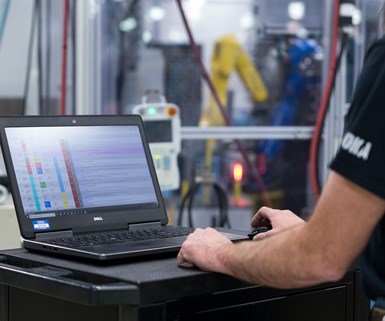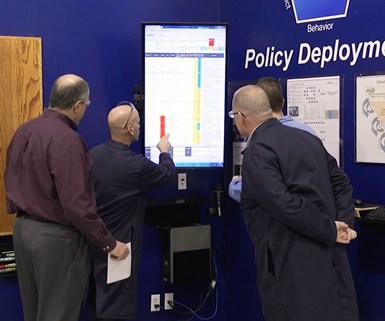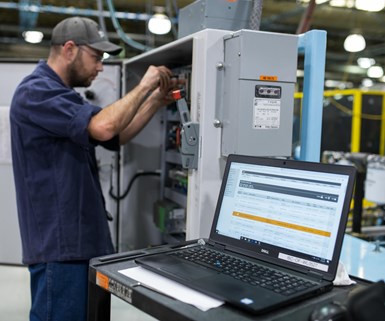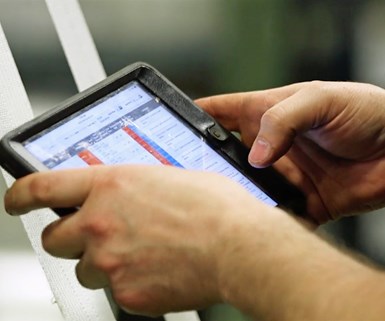Lean Strategies Drive Automotive Efficiency
A cloud-based lean execution system tying together multiple MES and ERP platforms across this automotive supplier's global operations has led to improvements in production, maintenance and quality.

Autoliv identifies most important issues to resolve using visualized data from Cloud Dispatch.
A worldwide leader in automotive safety, this supplier, headquartered in Sweden, insists on seeking the best partners, technology solutions and operations enhancements to support its efforts toward lean efficiency. As such, in 2010, the company introduced to a couple of its U.S. plants a lean execution system (LES) designed to help manufacturers create a culture of sustainable continuous improvement while simultaneously boosting production, maintenance and QA metrics. The system’s effectiveness led to quick rollout across its remaining North American operations and eventual worldwide implementation.
Lean Automotive Operations
Autoliv is a Fortune 500 company headquartered in Stockholm, Sweden. It has more than 80 plants spanning 27 different countries, including eight in the U.S. The company develops, manufactures and markets airbags, seatbelts and steering wheels, selling to all leading car manufacturers in the world.
Being a major player in the automotive industry, Autoliv had significant guidance from Toyota on implementation of the Toyota Production System (TPS). Considered a precursor of lean manufacturing, TPS was initially developed by key industrial engineers at Toyota, and further developed within the company over time. The overarching principle is to conserve resources by eliminating waste.
As part of its TPS philosophy, Autoliv focuses heavily on operational availability, making sure the machines are able to run and being fully aware of related disruptions such as issues relating to materials, quality and safety. The company had a number of add-on systems in place to signal abnormalities that impact production, but it was somewhat fragmented.
Communication is Key

Real-time notification, accessible throughout the organization, is used to dispatch technicians to resolve equipment issues.
In 2010, the company turned to Leading2Lean for implementation of its Cloud Dispatch LES in two Autoliv plants in Utah. While Leading2Lean is not a lean consulting company, its software products hardwire lean into organizations. Cloud Dispatch is the core of its solution.
This product promotes communication throughout the facility through strategies that focus on the resolution of quality or machine issues, scheduling of maintenance/preventive maintenance actions, setting up audits, and so on. It includes a document piece that can link to multiple document systems and load documents to the cloud. It puts information at people’s fingertips.
When an issue arises, the system creates a dispatch, communicating to the appropriate people via text or email messages. People who respond can see a complete history of the equipment involved and the related production line, accessing data on cell phones, tablets or terminals on the shop floor. Has the material lot been changed recently? Did maintenance recently work on the machine? Is there a quality issue? All of the documentation related to that equipment can be pulled up, including machine manuals and product drawings. It takes multiple systems that previously would have had to have been accessed separately and pulls them together into one place.
Add-on modules are also available. A production module tracks overall equipment effectiveness (OEE), operational availability and production throughput. The system is integrated to the enterprise resource planning (ERP) or material requirements planning (MRP) systems to track production orders, allowing real-time visibility into when and why an order is late. The skills module tracks all training, ensuring that people on the production line, including those troubleshooting problems, are properly qualified. The quality module tracks quality parameters for inspections. Lean tools, such as Kaizen (improvement opportunities), Yokoten (best practice sharing), TPM, and Problem Solving facilitate the right environment for continuous improvement.
Maximizing Potential
When Autoliv first implemented the LES system, its objective was to improve operational availability of the production lines, but as use of the system increased, quality, cost of product, employee training, employee certification and other production metrics also improved.
In modern manufacturing, automation and mechanization are standard. When any process, material, equipment, quality or personnel abnormality impacts a production line’s ability to perform at standard, immediate action is necessary to identify the root causes and implement resolutions that resolve them quickly. Production lines at Autoliv, as with any manufacturer, cannot fail—they are revenue generators and are critical to their mission of saving more lives.
Autoliv wanted a single, common production system across all lines, functions and plants that would harmonize existing disparate systems, fix data gaps and drive lean actions toward creating a sustainable culture of continuous improvement. The company found that Cloud Dispatch provided maintenance and production teams with real-time data visualization about production effectiveness, equipment, parts and history during abnormality assessments and line repair work. It accelerated improvement by getting the right information to the right people at the right time.
Validate and Expand
By 2012, successful performance of the original plants convinced Autoliv leadership to expand the use of the system to several additional plants in North and South America. The increased real-time visibility in the plants means problems are identified and resolved with higher speed and permanency because of integrated lean tools such as Yokoten, Kaizen and problem solving. Best-practice lean principles on the plant floor incent workers to identify, correct and share problem resolutions.
Because the system is cloud-based, its deployment was not disruptive or risky to Autoliv’s production lines and did not require any investment in computer technology—something all manufacturers are understandably reluctant to undertake. Cloud Dispatch reflects the reality of the plant floor and integrates existing legacy systems, thus eliminating the need to “rip and replace” across the global plant network. Autoliv has grown through acquisitions, so many of the sites use different ERP, manufacturing execution systems (MES) and MRP platforms. Cloud Dispatch was able to successfully overlay all of these systems using an advanced application program interface (API) solution.
Autoliv also saw improved employee contribution and engagement. The employees not only had better visibility, but also the ability to act, make improvements, quickly identify abnormalities, report issues and suggest improvements while in the task, not after. By eliminating manual processes such as binders, spreadsheets and whiteboards, the system provided full plant visibility, empowering the human element and harnessing human intelligence and intuition.
Going Global

Technicians can access relevant machine information on mobile devices or workstations on the shop floor during a fix.
In late 2014, Autoliv went through a structural reorganization, moving to a product-based organizational structure rather than one based on locale. One of the benefits of this shift was more collaboration among sites across the world, which facilitated more communication and sharing of ideas. Company leadership could see which sites were performing better and why.
The Executive Manufacturing Team initiated a process of looking across the whole organization for the best way to measure success and drive global alignment. In reviewing company performance, it was hard to not notice that the company’s plants in North America were highly efficient in production, maintenance and quality, largely driven by the capabilities provided by Cloud Disptach.
Performance of these plants was a signal that what was working well could be even better. If those plants were functioning with more efficiency, it was vital to standardize their best practices across all of the company’s plants. Using Cloud Dispatch as the common solution and scorecard throughout the company could create a long sought-after global plant standard, augment lean performance, drive a culture of sustained continuous improvement and improve employee engagement. It would also reduce the number of systems with which employees would need to interact by allowing the system to be the single interface.
The global rollout included more than 80 plants in 27 countries and was completed in 2017. “The speed and smoothness of the global LES deployment has set a benchmark for us,” says Brandon Jeppsen, vice president of information technology.
The pace of the global implementation was possible because cloud-based systems don’t require the infrastructure investment that on-premise systems do. The LES was adaptable enough to work with different computer hardware and existing systems across the entire network. The average plant rollout took about 6 to 8 weeks from install to being fully operational. Deployment training, on average, was less than a week per plant.
Data Security and Industry 4.0
Manufacturers see their manufacturing processes as highly proprietary and a competitive advantage that must be protected. Autoliv required that its cloud solution provider has demonstrated security controls that meet specific data protection measures for doing business globally. “We evaluated Leading2Lean’s security measures in great detail and see them as a partner that we can work closely with now and in the future,” Mr. Jeppsen says.
The company recognized the benefits of a cloud-based solution for its factories—allowing these facilities to retain their uniqueness while taking advantage of the cloud’s ability to work across legacy systems; be updated and enhanced quickly without full plant shutdowns; and improve efficiency, quality and standardization.
The solution has helped Autoliv advance deeply into Industry 4.0 by using technological advancements to engage and empower the workforce to innovate and solve problems. Giving employees full visibility, more responsibility and more freedom to act, combined with fast, accurate data, leads to real and measurable results. “We’ve learned that the benefits to our company and the individuals can extend out of the traditional knowledge worker environment all the way down to the manufacturing process,” Mr. Jeppsen says.
Measurable Results

Cell phones and tablets provide easy access to a complete history of the equipment and the related production line.
The results of the LES implementation have been impressive. By the end of 2017, operational availability had shown 5% global improvement, with some sites as high as 23%. Response time to production issues had 30% improvement, and there was a 12% reduction in cost of spare parts. Cost of product had also gone down and improvements in other areas such as preventive maintenance completion, overall equipment effectiveness, mean time to repair and response time to quality issues were also realized.
Those results are exciting, but they don’t tell the full story. In each case, the true benefits stem from the empowerment of the employees. The real-time visibility in the task that the company emphasizes as one of the system’s core benefits gave company leadership insights into the truth of what was happening on the plant floor.
Autoliv went beyond sensors and data to empower the workforce, which became engaged to leverage data and problem solve, creating a sustainable culture of continuous improvement.
Autoliv | autoliv.com
Leading2Lean | 877-225-5201 | leading2lean.com
Learn More
For similar articles about shop control software, visit PM’s ERP, Management and Related Software Zone.
Related Content
ERP Software Enables Manufacturers to Maximize Operational Efficiencies
PMTS 2023: JobBoss2 from ECI Software Solutions assists manufacturers with decision-making and reveals opportunities for growth and cost savings.
Read MoreProShop Provides ERP Technology to Purdue Engineering School
The ProShop Digital Ecosystem will be used as the inventory management and ERP system at Purdue University’s Industrial Engineering School.
Read MorePaperless Parts' AI-Powered Automation Tool Streamlines Quoting
Wingman is powered by a secure AI model developed to extract critical information from quote packages so that estimators can work faster, automate administrative aspects of setting up quotes and minimize the risk of missing important details.
Read MoreDatanomix Automated Production Intelligence Platform for ProShop ERP Software
PMTS 2023: Automated Job Costing analytics compare ProShop ERP target cycle times to actual process performance in the Datanomix Automated Production Intelligence Platform.
Read MoreRead Next
5 Aspects of PMTS I Appreciate
The three-day edition of the 2025 Precision Machining Technology Show kicks off at the start of April. I’ll be there, and here are some reasons why.
Read MoreDo You Have Single Points of Failure?
Plans need to be in place before a catastrophic event occurs.
Read MoreEmerging Leaders Nominations Now Open
Here’s your chance to highlight a young person in your manufacturing business who is on the path to be a future leader moving your company forward.
Read More













.jpg;maxWidth=300;quality=90)








